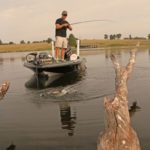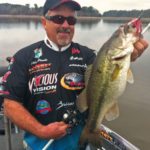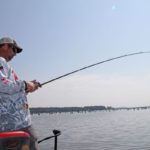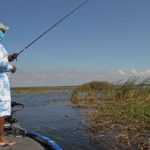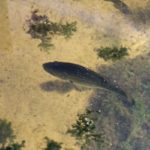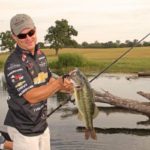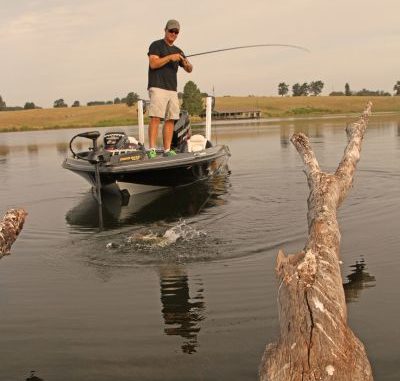
Glare from sunlight bouncing off the water can be an angler’s worst nightmare — especially when sight fishing. Here are some ways to manage that problem.
Seeing is believing, but you’d better believe that too much of a good thing — namely, sunlight — can make it tough for you to see what you’re seeking.
No doubt, when the water looks like a mirror flashing emergency signals and the lily pads reflect the sun like miniature spotlights, this illumination overload can greatly impede your fishing efficiency.
From vision limitations to simple irritation and discomfort, you might mentally lament, “This glare’s gotta go.”
In truth, the sun heeds no man’s request, so when days are bright, we just have to deal with it. Of course, how you deal with it will greatly impact your day.
Bear in mind that objects on the shoreline — trees, boat houses, etc. — can create shadow pockets that lessen the glare and offer you better glimpses of your target area.
It’s definitely a trade-off, as you need light penetration for any level of subsurface visibility. However, there’s always a sweet zone where you have just enough solar illumination tempered by blending shadows to create those areas of optimal visibility.
Such zones of optimal conditions might not cover the entire area you want to fish, but leverage these windows to pick up key details on water clarity, cover and fish positioning.
Identify a formula and it’s likely to hold up in similar spots.
Example: Docks, particularly those with boat houses, present strong shadow lines behind which you’ll get a good look at what’s going on below the surface. Are bass holding on the edges or underneath? Are there lots of bluegill? Any grass around the dock?
You might want to approach from an angle other than what you’ll actually fish, if this affords you a little precast recon.
Similarly, keep a close watch for transitional areas, where lighter sandy bottom meets the edge of hydrilla or other vegetation. Such zones of strong contrast make it easier to detect fish movement in bright conditions.
“I always try to fish with the sun at my back because that cuts down on some of the glare,” Bassmaster Elite Series pro Todd Faircloth said. “It kind of acts like an umbrella.”
In the interest of stealth, Faircloth is quick to note the wisdom of situational awareness — specifically where it concerns the physics of objects blocking a light source.
“With the sun at your back, you have to pay attention to your shadow,” he said. “You don’t want your shadow falling across what you’re about to fish because this will alert the fish to your approach and possibly spook them.”
Now, rare is the situation when you have one tightrope line of approach to a fish or a target area, so work with the directional options to “clock” your shadow around to an unobtrusive position.
“You have to find the right angle,” Elite Series pro Edwin Evers said. “With the sun, there’s always going to be direction (from which) you can see farther. So once you establish that, then that’s how you need to approach your fish.
“Maybe it’s with the sun behind you or off to your side, but you just have to find the right angle.”
During the early morning and late-afternoon periods, the sun’s lower angles give you what’s known in photography circles as “sweet light” — roughly daybreak until 9 a.m. and then again from about 5 p.m. until sunset.
Exact times vary by season and sky conditions certainly influence this with varying degrees of atmospheric moisture, but pay attention to sun angles and you’ll develop an instinctive sense for when to expect different light periods.
“When the sun gets up high around noon, that’s when light penetration will be at its strongest,” Faircloth said. “That’s when you can see the best, but it’s also when you have the most glare.”
So, what can you do when the sunlight is most intense? Sometimes, solid objects can be your best friend, as their existing shadows can absorb yours.
“A lot of times, I’ll use boat docks or trees or bushes in the water to put them between me and the fish to camouflage myself — I keep those between me and a fish,” Evers said.
Buttressing these strategies, sunlight management starts with what you wear.
“First and foremost is a good polarized pair of sunglasses,” Faircloth said. “I like to use a style that covers the sides so glare can’t get in.”
Faircloth uses the Strike King S11 series glasses, which feature 11 layers of polarized technology that tailor the light spectrum to enhance visual clarity, reduce glare and prevent reflection off the rear of the lens.
Knowing that he’ll likely face varying light conditions during an average day, Faircloth keeps multiple pairs of glasses with different lens colors on his boat. He prefers lighter colors like yellow in the mornings and moves to amber or gray for brighter midday periods.
Pete Ponds, an Elite Series pro from Mississippi, backs up Faircloth’s assertions by recalling a specific revelation that he acquired through the new lens technology of his Vicious Vision sunglasses. (See sidebar title “Light and lenses:)
“During a post-spawn pattern, the bass were relating to bream beds — feeding on the bream,” Ponds said. “Because I could see down into the water, I could see things that other guys couldn’t. This has really made a difference in my sight-fishing.”
A hat with a visor is pretty much standard issue, but pick one with a long bill and you’ll appreciate the extended sun-blocking ability.
World Fishing Network host Capt. Bill Miller offers this tip: Hats with lighter material under the bill tend to reflect more light toward your eyes, so he looks for hats with dark undersides. If you have a favorite hat with a light underside, use a black permanent marker to change it to a light-absorbing tone.
Some anglers prefer wider, boonie-style hats for sight fishing. Elite pro Ish Monroe prefers the Simms Gore-Tex Sombrero, which offers full-circumference sun blocking with the option of folding up either or both side via hook-and-loop connectors for the safari look.
“The wide brim reduces sunlight around my face and allows me to look out from a darker corridor,” Monroe said. “I use this along with Cocoons sunglasses, which feature a frame that isolates my eyes from any light reflection.
“Together this setup allows me to keep my eyes wide open when I’m scanning for fish or shallow structure.”
Faircloth takes this a step further with his outerwear. Ever wonder why most tournament pros have hoods on their jerseys? Well, it’s not only for cooler weather — it’s a sight-fishing benefit.
“That conceals my face and keeps the light from coming in,” Faircloth said. “I try to use a blue or a white (hoodie) — something that fits the sky background.
“I don’t want to use something that’s really bright because that stands out too much.”
Now, glare isn’t the only concern on bright days — you also need to plan for your comfort and protection from solar forces.
Even on warm days, long-sleeve shirts and long pants are your best bet for keeping the sun off your skin. Lightweight materials will prevent overheating, while the SPF built into many modern designs will prevent the sun from penetrating thin fabrics.
Simms, Columbia and other manufacturers now make lightweight shirts and pants in white/blue patterns that camouflage the angler by allowing them to blend into the sky above. As Evers pointed out, the more you can distort your profile to a fish looking up, the easier it is to approach in bright conditions.
Lightweight gaiters like the original Buff are a handy item with many comfort options — neck protection, full head masking, head band, etc. Today, branded versions are not hard to come by, and used in concert with a cap and sunglasses you can completely shield your face from the sun.
Note: These gaiters are also helpful in holding your sunglasses in place, should you ever find yourself without a neck strap.
Round out the package with lightweight sun gloves like those from Columbia, Tailing Toads or Cabela’s and you’ll keep cool while keeping yourself in the game.
You can’t stop the glare, but you can lessen its impact on you and your fishing.
